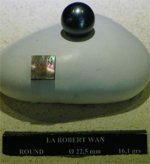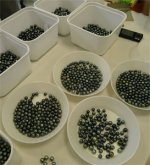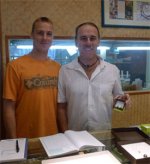Cyril Roger Brossard
Well-known member
- Joined
- Aug 30, 2012
- Messages
- 408
Tourists the world over flock to Tahiti, not just for the beloved sun, but also to stock up on the island's gems: Tahitian pearls. Rare in their uniqueness and vivid color, each pearl is singular to the island, reflecting the glittering lagoons of French Polynesian coral islands.

Le M?ridien Tahiti invited me to take a tour to discover the island's treasures. Take this handy guide with you on your next journey to arm you with knowledge to bring back your own rare collection.
The Mus?e de la Perle, while a thinly veiled retail store for luxe pearl pioneer Robert Wan, is a great place to start your trek in Tahiti. Walk past the glass cases of Wan pearls (seen in main image), unless you feel compelled to buy a gorgeous strand with a brand name behind it. The left and right wings of the small center offer an exhibit to discover the visual history of the pearl.

First, learn how a pearl is made. In nature, sometimes a grain of sand would slip into an oyster, fixed on a coral reef. Over time, the oyster, this South Sea jewelry box, wraps the grain in successive layers of mother-of-pearl or aragonite, giving birth to a rare pearl. This process was seldom, however. In the 1960s, French Polynesia developed the art of grafting, which was then used in Japan. They inserted a small piece of pearl graft tissue into the oyster's heart, which would cultivate into a pearl. A diorama of a pearl farm shows the divers at work.

A series of wax figurines show viewers how the pearl was used in cultures and costumes spanning from pre-Colombian civilizations to Egyptian Kings to Victorian England. The museum is also a must-see for boasting the largest Tahitian round pearl (seen above). After learning about the pearl making process, head to the Maison de la Perle for a firsthand lesson in choosing quality pearls. The Maison exists to help support Tahiti's number two source of income for the island (after tourism). All pearls for export must pass through the Maison where a giant X-Ray machine scans tubs of pearls to make sure the coat meets the required 0.8 mm thickness - a sign that it has been cultured in Polynesian waters for at least a year and a half.
Pearls that don't pass the test, or are overly flawed otherwise, are bundled up and crushed to dust. Choose pearls as if choosing a rare gem. Don't just rely on common strands, but know that you can make a gorgeous piece of jewelry with one perfect pearl. When buying pearls, first take into account what shape you're looking for. Round doesn't necessarily mean better, as Drop, Oval, Baroque or Semi Baroque pearls can make for lovely hanging jewelry.
Tahitian pearls take on a variety of colors, from aubergine to green to gray to black. Nearby Japanese tourists flock to the island to pick up Peacock pearls, green on the outside and pink toward the center. European markets typically favor bluer shades. It's all a matter of personal taste. It is key when choosing pearls to look for luster - how the pearl absorbs and reflects the light. A dull pearl is a dead pearl.

Next, examine the pearl for dots and imperfections. While a flawless pearl is ideal, Grade B pearls, with a few marks throughout, are also considered a high-quality find. Consumers can find much larger pearls in the Grade C and D range, heavily marked or circled pearls, at lower prices if size is of importance.
Pick up a custom cleaning cloth for your purchases gratis at the Maison. Pearls are meant to be worn, as Tahitian pearls rehydrate on skin contact. Pearls stored in a dark jewelry box will quickly lose their radiance. And avoid perfume, hairspray and chlorine around your pearls as any acid can destroy their exterior.

Now, on to the purchasing. Art Or Tahiti is an unassuming shop in a strip mall right next door to the Le M?ridien Tahiti resort. Despite its unpretentious exterior, however, my mates and I found it to be easily the best place to purchase pearls in Tahiti. Owner Thierry Poilvet sells a variety of handcrafted pieces in the front, from gold drop earrings to diamond encircled rings. Customers can choose their own pearls and have Poilvet set them according to their designs in his workshop in the back. A team of artisans work on a variety of pieces daily. After designing a necklace and a pair of earrings, I drew a pair of safety pins that I'd been wanting as earrings and they fashioned them in gold in a two-day turnaround.
I bought a giant four-year-old baroque pearl to string on a gold wire necklace at an unheard of value. It always shocks people when I tell them the marble-sized object around my neck is a pearl. For the best knowledge, service and personalization available, Art Or is the place to go.
An article by Ariston Anderson.

Le M?ridien Tahiti invited me to take a tour to discover the island's treasures. Take this handy guide with you on your next journey to arm you with knowledge to bring back your own rare collection.
The Mus?e de la Perle, while a thinly veiled retail store for luxe pearl pioneer Robert Wan, is a great place to start your trek in Tahiti. Walk past the glass cases of Wan pearls (seen in main image), unless you feel compelled to buy a gorgeous strand with a brand name behind it. The left and right wings of the small center offer an exhibit to discover the visual history of the pearl.

First, learn how a pearl is made. In nature, sometimes a grain of sand would slip into an oyster, fixed on a coral reef. Over time, the oyster, this South Sea jewelry box, wraps the grain in successive layers of mother-of-pearl or aragonite, giving birth to a rare pearl. This process was seldom, however. In the 1960s, French Polynesia developed the art of grafting, which was then used in Japan. They inserted a small piece of pearl graft tissue into the oyster's heart, which would cultivate into a pearl. A diorama of a pearl farm shows the divers at work.

A series of wax figurines show viewers how the pearl was used in cultures and costumes spanning from pre-Colombian civilizations to Egyptian Kings to Victorian England. The museum is also a must-see for boasting the largest Tahitian round pearl (seen above). After learning about the pearl making process, head to the Maison de la Perle for a firsthand lesson in choosing quality pearls. The Maison exists to help support Tahiti's number two source of income for the island (after tourism). All pearls for export must pass through the Maison where a giant X-Ray machine scans tubs of pearls to make sure the coat meets the required 0.8 mm thickness - a sign that it has been cultured in Polynesian waters for at least a year and a half.
Pearls that don't pass the test, or are overly flawed otherwise, are bundled up and crushed to dust. Choose pearls as if choosing a rare gem. Don't just rely on common strands, but know that you can make a gorgeous piece of jewelry with one perfect pearl. When buying pearls, first take into account what shape you're looking for. Round doesn't necessarily mean better, as Drop, Oval, Baroque or Semi Baroque pearls can make for lovely hanging jewelry.
Tahitian pearls take on a variety of colors, from aubergine to green to gray to black. Nearby Japanese tourists flock to the island to pick up Peacock pearls, green on the outside and pink toward the center. European markets typically favor bluer shades. It's all a matter of personal taste. It is key when choosing pearls to look for luster - how the pearl absorbs and reflects the light. A dull pearl is a dead pearl.

Next, examine the pearl for dots and imperfections. While a flawless pearl is ideal, Grade B pearls, with a few marks throughout, are also considered a high-quality find. Consumers can find much larger pearls in the Grade C and D range, heavily marked or circled pearls, at lower prices if size is of importance.
Pick up a custom cleaning cloth for your purchases gratis at the Maison. Pearls are meant to be worn, as Tahitian pearls rehydrate on skin contact. Pearls stored in a dark jewelry box will quickly lose their radiance. And avoid perfume, hairspray and chlorine around your pearls as any acid can destroy their exterior.

Now, on to the purchasing. Art Or Tahiti is an unassuming shop in a strip mall right next door to the Le M?ridien Tahiti resort. Despite its unpretentious exterior, however, my mates and I found it to be easily the best place to purchase pearls in Tahiti. Owner Thierry Poilvet sells a variety of handcrafted pieces in the front, from gold drop earrings to diamond encircled rings. Customers can choose their own pearls and have Poilvet set them according to their designs in his workshop in the back. A team of artisans work on a variety of pieces daily. After designing a necklace and a pair of earrings, I drew a pair of safety pins that I'd been wanting as earrings and they fashioned them in gold in a two-day turnaround.
I bought a giant four-year-old baroque pearl to string on a gold wire necklace at an unheard of value. It always shocks people when I tell them the marble-sized object around my neck is a pearl. For the best knowledge, service and personalization available, Art Or is the place to go.
An article by Ariston Anderson.
